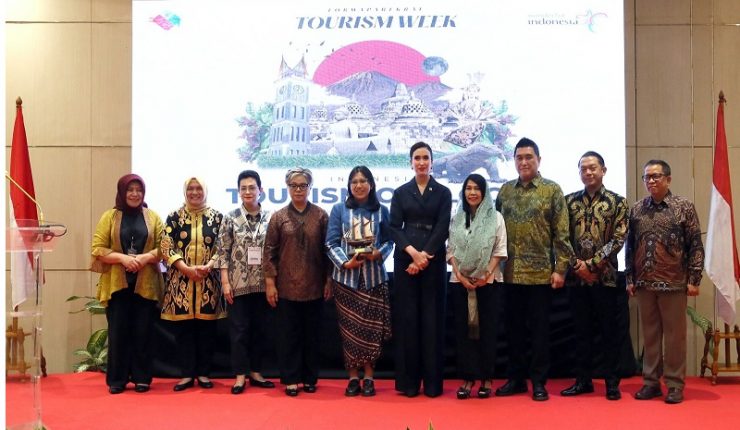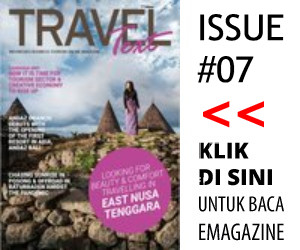INDONESIAN tourism is now moving towards a new era that demands a balance between sustainability and economic growth. This spirit is reflected in the Indonesia Tourism Outlook (ITO) 2026 which was held by the Tourism and Creative Economy Journalists Forum (Forwaparekraf) on Wednesday (10/29), 2025) at ARTOTEL Harmoni Jakarta.
According to Tiara Maharani, Chairwoman of Forwaparekraf, in her speech at the opening of the talkshow, said that with the theme Navigation towards Sustainable, Powerful and Profitable Tourism, ITO is an annual forum that brings together the government, industry players, investors and the media to discuss new directions for Indonesian tourism amidst global change.
“Since it was first held in 2018, ITO has existed as a space for reflection and collaboration across sectors. This forum discusses how the tourism industry can grow sustainably by balancing economic, social and environmental interests,” she said.
Through ITO 2026, Forwaparekraf emphasizes that sustainability is not just a discourse, but a new direction for the Indonesian tourism industry. Economic growth remains the goal, but it must go hand in hand with social responsibility and environmental sustainability.
Meanwhile, Tourism Minister Widiyanti Putri Wardhana emphasized that I had identified three global trends that could fundamentally change the landscape and open up great opportunities for Indonesia’s tourism sector in the future. Tourism has been recognized as a vital engine of world economic growth, with far-reaching and significant social impacts.
“In 2023, the tourism sector will contribute around 10% to global GDP and create jobs for 330 million people worldwide. In Indonesia, Bank Mandiri estimates that the tourism sector’s contribution to the national economy will reach 4.9% in the first semester of 2025, with employment of around 25.88 million people,” Widiyanti affimed.
However, amidst these achievements, global tourism is experiencing a significant trend shift. This shift is projected to bring great opportunities for Indonesia, including through changes in tourist sources, tourist demographic dynamics, and destination selection patterns.
The first trend explained is the change in sources of outbound tourists, which are now increasingly diverse. If previously the world tourism market was dominated by tourists from America, Europe and East Asia, now countries from South America, South Asia and the Middle East, including Indonesia, are expected to enter the top 15 world outbound markets by 2040.
“This condition emphasizes the importance of adapting Indonesia’s tourism offer so that it remains relevant and attractive to new tourist segments, while also opening up opportunities to develop special interest tourism,” she noted.
One form of this is the development of Muslim-friendly tourism which is now increasingly in demand by global tourists. According to Crescent Ratings, by 2030 total spending by Muslim tourists is estimated to reach more than US$235 billion. With the largest Muslim population in the world, Indonesia has an ecosystem and facilities that support the needs of Muslim tourists. This gives Indonesia a competitive advantage to strengthen its position as a Muslim-friendly destination at the global level.
The second trend is changes in tourist demographics. Generation Z and millennials are now the new drivers of world tourism growth with high interest in traveling. Therefore, Indonesian tourism needs to provide experiences that suit the preferences of this generation.
The younger generation tends to look for inspiration through social media, travel creators and generative AI. They also prioritize meaningful and narrative experiences with as many as 52% of Gen Z even willing to pay more to get a memorable travel experience.
“This change opens up great opportunities for promoting Indonesian tourism with a targeted and experience-based digital approach. With the right strategy, we can reach the global market more efficiently and personally,” said Minister Widiyanti.
The third trend is changes in destination selection patterns. Destinations that were previously not top of mind or only used as destinations are now increasingly popular with tourists.
“In the Southeast Asia region, the proportion of visits to destinations like this is expected to increase from 24 percent in 2023 to 30% in 2030. This opens up opportunities for Indonesia to repackage and enrich its tourism product, by combining popular destinations and surrounding niche destinations to create more authentic tourism packages,” she concluded.
Meanwhile, Eduard Rudolf Pangkerego, Chief Operating Officer of ARTOTEL Group, emphasized the importance of transformation towards more responsible business practices. Now on the stock exchange, we have to issue a correct ESG (Environmental, Social & Governance) report. We touch on green investment and greener activities, not only in the green but also the blue economy.
“For this reason, we launched The Art of Goodness program. Apart from pursuing profit, we are also responsible for people and the planet,” stressed Eduard.
According to him, sustainability cannot just be a slogan. Every industrial player needs to ensure that their business operations provide benefits to the local community and protect the environment. I emphasize that the balance between profit and social responsibility is a real form of empowering and profitable tourism.
Likewise, Yudhistira Setiawan, SVP Corporate Secretary of Injourney said that sustainability practices at the business level also play an important role in strengthening destination competitiveness. In line with that, Indonesia’s strength is not only in the number of destinations but in the uniqueness of the experiences it offers.
“Indonesia has the largest tourism assets in Southeast Asia, but our number of visits is still behind Thailand and Malaysia. For this reason, each destination needs to have a clear and competitive positioning,” he said.
He added that Injourney is now focusing on developing five Super Priority Tourism Destinations (DPSP), namely Borobudur, Lake Toba, Labuan Bajo, Mandalika and Likupang. The five development pillars that serve as a reference include attractions and programs, connectivity, infrastructure and amenities, sustainable tourism, and people and hospitality. This approach is expected to create an inclusive, productive and environmentally friendly tourism ecosystem.
At the same, Vivin Harsanto, Executive Director and Head of Strategic Consulting JLL Indonesia said trends and challenges in Asia-Pacific, well, the overview of tourism trends in Asia Pacific shows a new direction that supports the theme of sustainability. Based on the results of a JLL Indonesia survey of 1,000 Gen Z and millennial respondents, nature-based tourism, authentic culture, wellness and culinary are the main choices.
“The younger generation is looking for meaningful experiences, not just popular destinations. They want to be close to nature, history and local communities. The attractiveness of a destination alone is not enough. Challenges still come from connectivity, infrastructure, to digital access and payment systems in remote areas,” she noted.
Vivin concluded that prospective tourists are now more sensitive to value for money. We must ensure that Indonesia is competitive, not only beautiful, but also easily accessible and worth visiting. Apart from connectivity, the quality of accommodation and entertainment also needs to be improved so that the tourist experience becomes completer and more memorable. [traveltext.id]
















